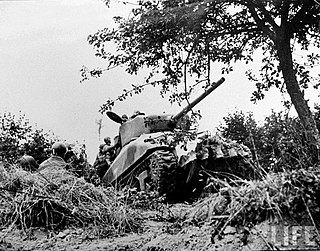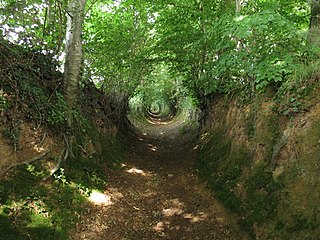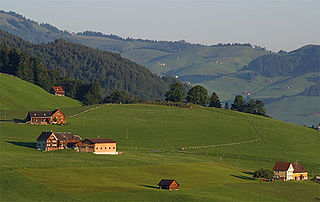
Normandy is a geographical and cultural region in northwestern Europe, roughly coextensive with the historical Duchy of Normandy.

Lower Normandy is a former administrative region of France. On 1 January 2016, Lower and Upper Normandy merged becoming one region called Normandy.

A hedge or hedgerow is a line of closely spaced shrubs and sometimes trees, planted and trained to form a barrier or to mark the boundary of an area, such as between neighbouring properties. Hedges that are used to separate a road from adjoining fields or one field from another, and are of sufficient age to incorporate larger trees, are known as hedgerows. Often they serve as windbreaks to improve conditions for the adjacent crops, as in bocage country. When clipped and maintained, hedges are also a simple form of topiary.

Aunay-sur-Odon is a former commune in the Calvados department in the Normandy region of north-western France. On 1 January 2017, it was merged into the new commune Les Monts d'Aunay.

"Rhino tank" was the American nickname for Allied tanks fitted with "tusks", or bocage cutting devices, during World War II. The British designation for the modifications was Prongs.

A hurdle is a moveable section of light fence. In the United States, terms such as "panel", "pipe panel" or simply "fence section" are used to describe moveable sections of fencing intended for agricultural use and crowd control; "hurdle" refers primarily to fences used as jumping obstacles for steeplechasing with horses or human track and field competition.

In the French formal garden, a bosquet is a formal plantation of trees in a wide variety of forms, some open at the bottom and others not. At a minimum a bosquet can be five trees of identical species planted as a quincunx, or set in strict regularity as to rank and file, so that the trunks line up as one passes along either face. In large gardens they were dense artificial woodland, often covering large areas, with tall hedges on the outside and other trees inside the hedges. Symbolic of order in a humanized and tamed gardens of the French Renaissance and Baroque French formal gardens, the bosquet is an analogue of the orderly orchard, an amenity that has been intimately associated with pleasure gardening from the earliest Persian gardens of the Achaemenid Empire.

A sunken lane is a road or track that is significantly lower than the land on either side, not formed by the (recent) engineering of a road cutting but possibly of much greater age.

A dispersed settlement, also known as a scattered settlement, is one of the main types of settlement patterns used by landscape historians to classify rural settlements found in England and other parts of the world. Typically, there are a number of separate farmsteads scattered throughout the area. A dispersed settlement contrasts with a nucleated village.
The study of field systems in landscape history is concerned with the size, shape and orientation of a number of fields. These are often adjacent, but may be separated by a later feature.

The English Lowlands beech forests is a terrestrial ecoregion in the United Kingdom, as defined by the World Wide Fund for Nature (WWF) and the European Environment Agency (EEA). It covers 45,600 km2 (17,600 sq mi) of Southern England, approximately as far as the border with Devon and South Wales in the west, into the Severn valley in the north-west, into the East Midlands in the north, and up to the border of Norfolk in the north-east. The WWF code for this ecoregion is PA0421.
A shaw is a strip of woodland usually between 5 and 15 metres wide. Shaws commonly form boundaries between fields or line a road.

Lawshall is a village and civil parish in Suffolk, England. Located around a mile off the A134 between Bury St Edmunds and Sudbury, it is part of Babergh district. The parish has nine settlements comprising the three main settlements of The Street, Lambs Lane and Bury Road along with the six small hamlets of Audley End, Hanningfield Green, Harrow Green, Hart's Green, Hibb's Green and Lawshall Green.

Landepéreuse is a former commune in the Eure department, in Normandy in northern France. On 1 January 2016, it was merged into the new commune of Mesnil-en-Ouche.

A Devon hedge, also known as a Devon hedgebank, consist of a rubble or earth bank that is usually topped with bushy shrubs forming a hedgerow, with trees also being a frequent and noticeable feature. The bank may be faced with turf or stone.

In gardening, a garden room is a secluded and partly enclosed space within a garden that creates a room-like effect. Such spaces have been part of garden design for centuries. Generally they are regarded as different from terraces and patios just outside a building, although in practice these are often the parts of a garden that are most used as a room, with tables and chairs. Walls and hedges may form part of the boundaries of a garden room, but plants, usually at least a few feet tall, will do as well. Apart from the entrances to the room, these should normally enclose the space. There may be furniture, especially for sitting down, but this is not essential.

Placenames in Normandy have a variety of origins. Some belong to the common heritage of the Langue d'oïl extension zone in northern France and Belgium; this is called "Pre-Normanic". Others contain Old Norse and Old English male names and toponymic appellatives. These intermingle with Romance male names and place-name elements to create a very specific superstratum, typical of Normandy within the extension zone of the Langue d'oïl. These are sometimes called "Normanic".

The Making of the English Landscape is a 1954 book by the English local historian William George Hoskins. The book is also the introductory volume in a series of the same name which deals with the English Landscape county by county.

In the Western history of gardening, from the 16th to early 19th centuries, a wilderness was a highly artificial and formalized type of woodland, forming a section of a large garden. Though examples varied greatly, a typical English style was a number of geometrically-arranged compartments closed round by hedges, each compartment planted inside with relatively small trees. Between the compartments there were wide walkways or "alleys", usually of grass, sometimes of gravel. The wilderness provided shade in hot weather, and relative privacy. Though often said by garden writers at the time to be intended for meditation and reading, the wilderness was much used for walking, and often flirtation. There were few if any flowers, but there might be statues, and some seating, especially in garden rooms or salle vertes, clearings left empty. Some had other features, such as a garden maze.

A woodland garden is a garden or section of a garden that includes large trees and is laid out so as to appear as more or less natural woodland, though it is often actually an artificial creation. Typically it includes plantings of flowering shrubs and other garden plants, especially near the paths through it.






















